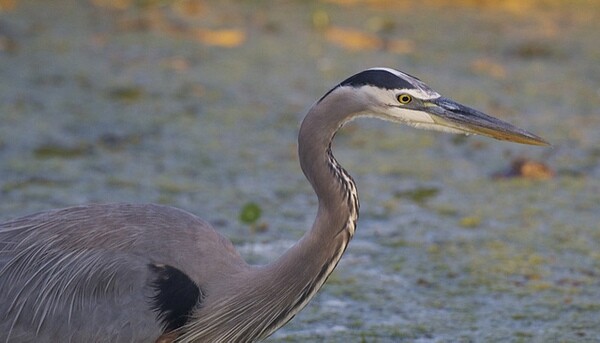Great Blue Herons Die at Solar Project

ReWire reported Wednesday that a surprising number of water birds are being found dead and injured at a pair of solar energy facilities in the California desert. Since publishing that story we've learned that the toll is greater than we reported: two great blue herons have been found dead at one of the projects.
According to compliance documents provided to ReWire by the California Energy Commission late Wednesday, the mortalities were discovered on June 28 and July 8 at the the 250-megawatt Genesis Solar Energy Project being built by NextEra about 25 miles west of Blythe in Riverside County.
Great blue herons are very large wading birds ranging from three to four and a half feet tall with wingspans in excess of six feet. Frequently seen in wetlands along the Colorado River and the Salton Sea, great blue herons are often spotted at the artificial Lake Tamarisk 25 miles west of the Genesis site, and project biologists have recorded a few sightings of the birds in the air above the site in the last year.

The documents the CEC provided ReWire were standard Avian and Wildlife Reporting Forms required under the project's Avian [a.k.a. "bird"] Protection Plan. According to those documents, the June 28 heron mortality was discovered when biologists found the dead bird leaning up against a chain link fence on the site designed to keep wildlife away from the project's evaporation ponds. Biologists noted that the bird showed no signs of blunt force trauma or entanglement in the fence.
In the July 8 incident, a dead heron was found inside an electrical building at one of the project's power blocks. Biologists offered no other comments on the bird's appearance in that document.
Both birds were buried near the site without necropsy, according to the reports.
CEC also provided ReWire with reports describing two additional water-oriented bird mortalities. These involved a cliff swallow and a yellow-headed blackbird, both species associated with open water habitats. Both birds were found in proximity to the site's evaporation ponds on July 1.
Like great blue herons, both cliff swallows and yellow-headed blackbirds generally just migrate through the desert surrounding the Genesis site. What prompted the four birds to visit the site is unknown, though as we speculated in Wednesday's piece, reflections from the project's mirrors could conceivably have persuaded the birds that water could be found on the site. The project's evaporation ponds are netted to keep birds out. That netting likely provides partial concealment of any water in the ponds to birds passing overhead, but that may have made little difference once the birds landed.
In the meantime, ReWire is learning of similar bird mortalities at solar sites other than Genesis and (mentioned Wednesday) Desert Sunlight, about 30 miles west. We'll check them out and keep you posted.


